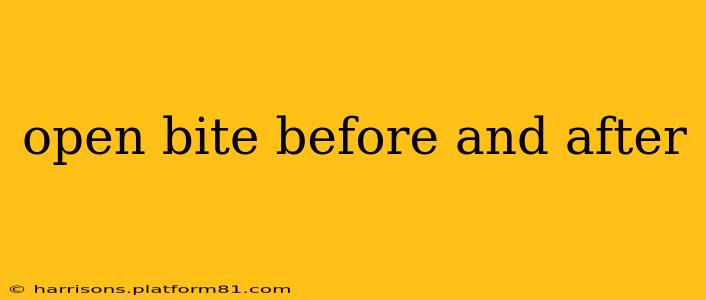An open bite is a malocclusion, or misalignment of the teeth, where the front upper and lower teeth don't come together when the mouth is closed. This leaves a noticeable gap or space between the incisors. While often a cosmetic concern, an open bite can also impact speech, chewing, and even the overall health of your jaw joint (TMJ). This comprehensive guide explores open bite correction, showing before and after transformations and discussing various treatment options.
What Causes an Open Bite?
Understanding the causes of an open bite is crucial for effective treatment. Several factors can contribute:
-
Thumb sucking or other oral habits: Prolonged thumb sucking, pacifier use, or tongue thrusting during childhood can exert pressure on the teeth and jaws, preventing proper alignment.
-
Genetics: In some cases, an inherited predisposition to an open bite can be a contributing factor. Family history of malocclusion should be considered.
-
Tongue posture: Abnormal tongue posture, where the tongue rests against the front teeth, can push the teeth out, creating an open bite.
-
Growth and development issues: Problems with the growth and development of the jaws, such as a skeletal discrepancy, can lead to an open bite.
-
Trauma to the jaw: Injuries to the jaw can sometimes result in malocclusion, including an open bite.
How is an Open Bite Corrected?
Treatment for an open bite depends on the severity and underlying cause. Several options exist, often combined for optimal results:
Orthodontic Treatment (Braces):
Braces are frequently used to correct open bites, especially those caused by teeth misalignment. Traditional metal braces, ceramic braces, and clear aligners (like Invisalign) can gently reposition the teeth to close the gap. The treatment duration varies depending on the individual case.
Orthognathic Surgery:
In cases of severe open bites caused by skeletal discrepancies, orthognathic surgery might be necessary. This surgical procedure realigns the jaw bones to correct the underlying skeletal problem. This is often followed by orthodontic treatment to fine-tune the teeth's position.
Myofunctional Therapy:
This therapy focuses on correcting oral habits, like tongue thrusting, that contribute to an open bite. It involves exercises and techniques to improve tongue posture and swallowing patterns. This is often used in conjunction with other treatments.
Open Bite Before and After Pictures: What to Expect
Before and after photos are a powerful testament to the transformative potential of open bite correction. These photos showcase the significant improvement in facial aesthetics and dental alignment achieved through treatment. While specific results vary, the general trend shows a closure of the open bite, improved tooth alignment, and a more balanced facial profile. The improvement is often dramatic, leading to increased self-confidence and a more harmonious smile. Note: Individual results will vary based on the severity of the open bite, the chosen treatment method, and individual patient factors.
What are the long-term effects of an untreated open bite?
Leaving an open bite untreated can have several long-term consequences:
-
Increased risk of TMJ disorders: The misalignment can strain the temporomandibular joint, leading to pain, clicking, and limited jaw movement.
-
Difficulty chewing: Proper chewing function may be compromised, potentially impacting nutrition and digestion.
-
Speech problems: An open bite can affect speech clarity, causing lisping or other articulation difficulties.
-
Increased risk of dental decay: The open bite can make it harder to clean the teeth effectively, increasing the susceptibility to cavities and gum disease.
-
Aesthetic concerns: Many individuals with an open bite experience self-consciousness about their appearance.
How long does it take to correct an open bite?
The treatment duration for an open bite varies significantly depending on the severity of the condition and the chosen treatment method. Orthodontic treatment alone might take 12-36 months or more, while combined orthodontic and surgical approaches can extend the treatment timeline. Myofunctional therapy can be a long-term commitment, requiring consistent practice for optimal results. Your orthodontist or surgeon will provide a personalized treatment plan and estimated timeframe during your consultation.
Are there any risks associated with open bite correction?
As with any medical procedure, there are potential risks associated with open bite correction. These may include discomfort, pain, swelling, and potential complications related to the specific treatment method (e.g., orthodontic appliances, surgery). Your dentist or orthodontist will discuss these risks thoroughly during your consultation. Proper post-treatment care is crucial for minimizing risks and ensuring optimal healing.
This information is for general knowledge and should not be considered medical advice. Always consult with a qualified orthodontist or dentist for diagnosis and treatment planning. They can assess your individual needs and recommend the most appropriate course of action.
